IFFO’s Members’ Meeting in Miami has been attended by 220 delegates from 29 countries.
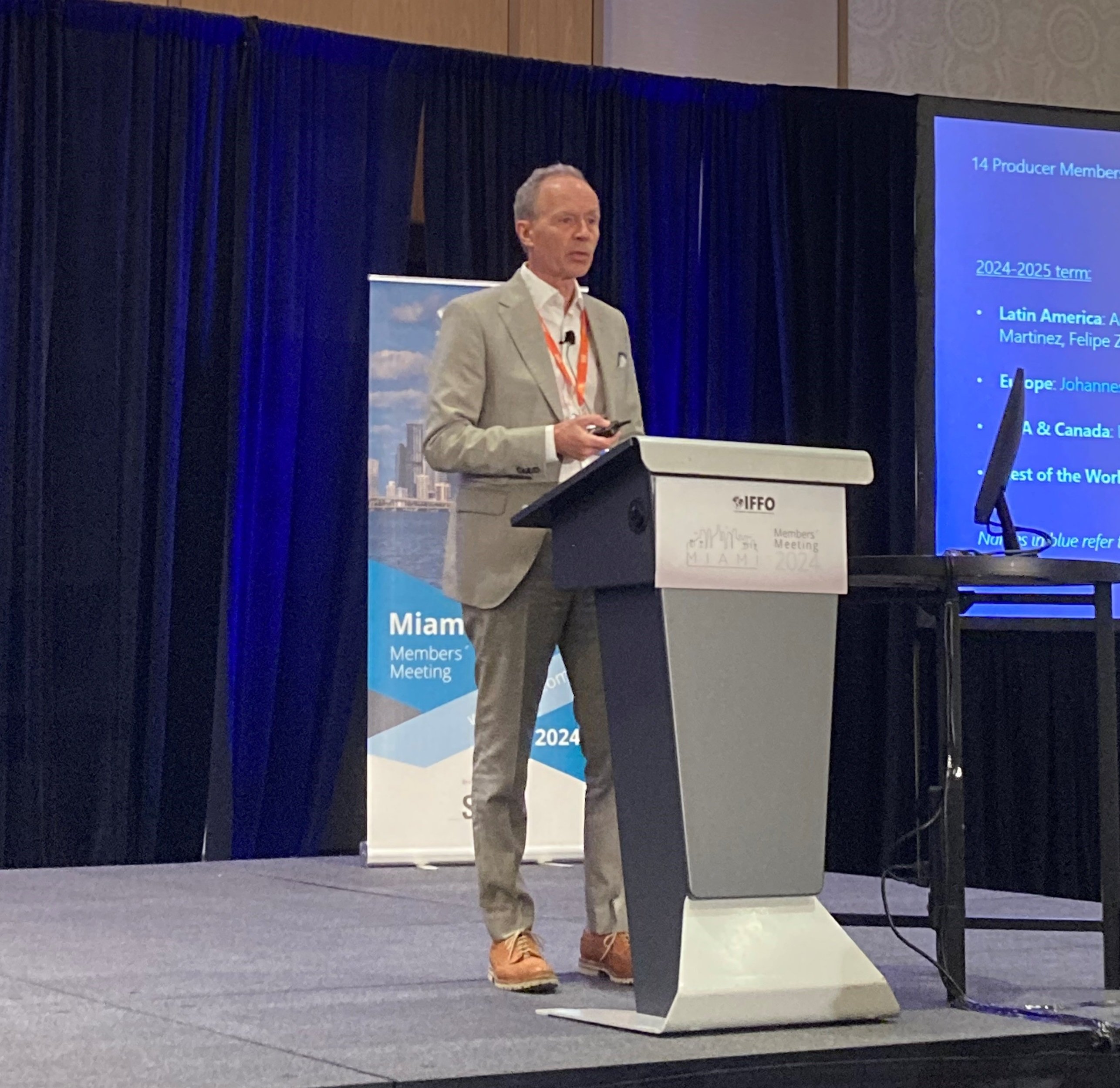 The event was opened by IFFO’s new President Egil Magne Haugstad (CEO of Pelagia), who dived into the 65-long history of IFFO as a membership organisation. Based on science, IFFO works to lead the responsible development of marine ingredients, progressing the industry by engaging with relevant stakeholders and contributing to the understanding of the feed ingredients landscape.
The event was opened by IFFO’s new President Egil Magne Haugstad (CEO of Pelagia), who dived into the 65-long history of IFFO as a membership organisation. Based on science, IFFO works to lead the responsible development of marine ingredients, progressing the industry by engaging with relevant stakeholders and contributing to the understanding of the feed ingredients landscape.
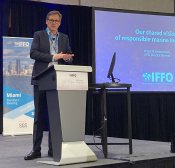 IFFO’s Director General, Petter Martin Johannessen took a broad view of the industry looking at the importance of measuring all the impacts of all feed ingredients, based on objective tools which provide a holistic view, instead of isolated metrics. “Taking into consideration a least cost formulation strategy, we now see that not only the nutritional and physical parameters are considered – also Life Cycle Assessment parameters are becoming increasingly important in formulation.”
IFFO’s Director General, Petter Martin Johannessen took a broad view of the industry looking at the importance of measuring all the impacts of all feed ingredients, based on objective tools which provide a holistic view, instead of isolated metrics. “Taking into consideration a least cost formulation strategy, we now see that not only the nutritional and physical parameters are considered – also Life Cycle Assessment parameters are becoming increasingly important in formulation.”
Insights into salmon farming
 Starting with a key consumer of marine ingredients, Damien Claire from Atlantic Sapphire, provided an overview of how the conventional net pen salmon farming industry has grown rapidly over the last five decades, however, in the last decade, the growth measured in annual production volumes has slowed down. This slowdown is primarily due to biological challenges across all the main producing regions (Chile and Norway), which are experiencing significant risk and costs related to disease, sea lice and other parasite management. Regulatory and environmental limitations may prevent this conventional industry from meeting growing demands. However, new technology such as offshore salmon farming and land-based salmon farming offer potential for future growth of sustainable salmon to fill the ever-growing gap between supply and the strong demand side.
Starting with a key consumer of marine ingredients, Damien Claire from Atlantic Sapphire, provided an overview of how the conventional net pen salmon farming industry has grown rapidly over the last five decades, however, in the last decade, the growth measured in annual production volumes has slowed down. This slowdown is primarily due to biological challenges across all the main producing regions (Chile and Norway), which are experiencing significant risk and costs related to disease, sea lice and other parasite management. Regulatory and environmental limitations may prevent this conventional industry from meeting growing demands. However, new technology such as offshore salmon farming and land-based salmon farming offer potential for future growth of sustainable salmon to fill the ever-growing gap between supply and the strong demand side.
The US is by far the largest salmon consumer market in the world with ~600,000 tons per year, but US production is scarce with consumers generally reliant on European or South American salmon imports today with significant freight cost. This had led Atlantic Sapphire to lead in the development of land-based salmon farming, with the world’s largest facility of its kind located in Miami, Florida.
“Fishmeal and fish oil are an important part of salmon’s diet. Novel ingredients are also needed. It is not either or. We need more protein, more fat, more omega-3s” he concluded.
Marine ingredient markets in North America
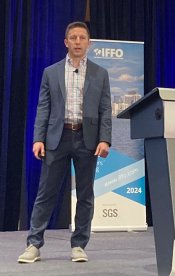 Staying in North America, The Scoular Company’s John Rodysill provided an update on fishmeal and fish oil demand in North America. In petfood, the last five to ten years has seen consistent growth, but this changed 2023 with the cutting of many premium ingredients with shifting consumer demand from buying the top shelf more expensive products to more generic products.
Staying in North America, The Scoular Company’s John Rodysill provided an update on fishmeal and fish oil demand in North America. In petfood, the last five to ten years has seen consistent growth, but this changed 2023 with the cutting of many premium ingredients with shifting consumer demand from buying the top shelf more expensive products to more generic products.
With pricing internationally dropping over the last 3-6 months, demand is now recovering for generic fishmeals and salmon meal for petfood. Annual demand for Canada and the US is at 240,000 MT (2023). There is also a return to normal buying habits for feed customers and aquaculture feed demand has also seen a similar recovery, with recent pricing drops and this trend is expected to continue throughout 2024. Concluding his talk, Rodysill noted the increased expectation for traceability from customers.
Global Omega-3 markets
Omega-3 ingredient oil use contracted by 0.6% in 2023 due to remaining stocks, which enabled brands to maintain the level of oils they could use, according to GOED’s Aldo Bernasconi. Growth is expected to resume in 2024 and return to an average annual growth rate at 2.5% until 2026, he stated.
In terms of geographies, the older, more established markets contracted in 2023 due to inflation and restricted supply. The fastest growing region was China, while Latin America, usually a fast-growing market although it accounts for very small volumes compared to the leading regions, remained relatively flat. The four largest markets, US, Europe, China and Asia Pacific, account for 80% of the global volume. Gains in Asia in 2023 did not suffice to compensate losses in the older, more established countries. Dietary supplements, heavily dependent on refined oil, contracted the most.
Pet foods, usually a fast growth category, was affected in 2023 by lower pet adoption rates and reduced levels of fortification. Low birth rates in China were offset by increased infant formula demand in other Asian markets.
About ⅔ of the omega-3 market demand for crude oils is supplied by Peruvian anchoveta. “Reliance on a single fishery leaves the omega-3 industry open to risk when supply is disrupted. It is unclear whether supply will recover sufficiently in 2024”, Bernasconi commented.
In 2023 on average, prices of omega-3 dietary supplements in the USA and Europe rose around 10%. Brands have been reluctant to pass full cost increases on to consumers.
Global fish oil market
Delving into just fish oil markets, Jorge Garcia Herz from Marex Global Sourcing in Peru started with the challenges faced in 2023 with El Nino greatly limiting fishing in Peru and the market shifts from that. “Every ton of EPA and DHA counts now” he commented.
“Circular oils, coming from by-products and side streams, accounting for 100,000 metric tonnes, have been here for years, but I call them the silent contributors, the elephant in the room”. Contents of EPA and DHA contents move from less than 1% to more than 60%.
Global omega-3 consumption is quite stable. Demand is supply driven. While the markets settle with Peru fishing heading back to normality, after a drop of production in Peru by 100,000 metric tonnes, smoother sailing is predicted for 2024-2025. Despite this drop, global production in 2023 was only down by 30,000 metric tonnes. “Considering the slow start of Scandinavia and Chile, it is likely that fish oil supply will be less tight on the human consumption side and tighter on the aquaculture side”.
Technologies will be decisive in providing more stability to the market, Garcia Herz concluded: using residual streams, increasing the bioavailability of EPA and DHA, enhancing concentration of fish oil for human consumption with weaker oils.
China Market Update
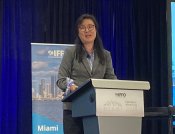 IFFO’s China Director Maggie Xu brought together the marine ingredient market picture for China. Domestic fishmeal demand has improved in the last year, with more local production from whole fish and supply of imported Russian sardine. We are also seeing the growing potential in fishery by-products driven by the fast expansion of ready-to-cook meals in China. Challenges still remain in the efficient collection of these by-products, but growth trends in this area are clear. In terms of fishmeal consumption, both aqua and pig farmers suffered losses and fishmeal demands have been restrained throughout last year until now. In these challenging conditions, feed producers have adapted their formulas to focus on cost reductions and lower inclusion rates. Lastly, demand from the pork sector has reduced due to farming losses and oversupply, with a reduction in pork production expected to continue in 2024.
IFFO’s China Director Maggie Xu brought together the marine ingredient market picture for China. Domestic fishmeal demand has improved in the last year, with more local production from whole fish and supply of imported Russian sardine. We are also seeing the growing potential in fishery by-products driven by the fast expansion of ready-to-cook meals in China. Challenges still remain in the efficient collection of these by-products, but growth trends in this area are clear. In terms of fishmeal consumption, both aqua and pig farmers suffered losses and fishmeal demands have been restrained throughout last year until now. In these challenging conditions, feed producers have adapted their formulas to focus on cost reductions and lower inclusion rates. Lastly, demand from the pork sector has reduced due to farming losses and oversupply, with a reduction in pork production expected to continue in 2024.
Looking at fish oil in China, the strong global market demand has encouraged domestic fish oil production and this is expected to continue this year, most notably with the imported sardine that offer very high oil yields. These high prices have added most cost controls on feed producers, reducing demand in the aquafeed sector and demand is instead increasing in the direct human consumptions sector.
Certified marine ingredients
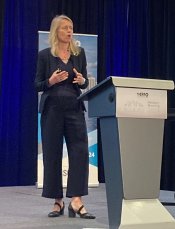 "MarinTrust meets a market need for assurances regarding the responsible sourcing and production of marine ingredients. Its uniqueness lies in the fact that it comes from the industry", Libby Woodhatch explained. A key requirement is to undergo testing and trial periods for the standards before they become effective, so as to ensure their robustness and credibility.
"MarinTrust meets a market need for assurances regarding the responsible sourcing and production of marine ingredients. Its uniqueness lies in the fact that it comes from the industry", Libby Woodhatch explained. A key requirement is to undergo testing and trial periods for the standards before they become effective, so as to ensure their robustness and credibility.
With Version 3 of its standard, coming into force on the 1st May 2024, it is about extending the standard's focus on environmental and social impacts, both at the factory level and on the vessels, and encouraging the use of by-products. Traceability has always been a key pillar of the standard, but it is an element that is being strengthened, providing a framework based upon the standards of the Global Dialogue for Seafood Traceability (GDST). Transition from current version 2 to version 3 will end on the 1st May 2025.









